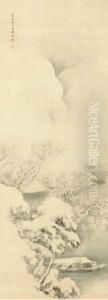Bunrin Shiokawa Paintings
Bunrin Shiokawa was a Japanese painter born in 1808, during the Edo period, a time when Japan was under the rule of the Tokugawa shogunate and largely isolated from the rest of the world. Shiokawa was part of the Maruyama-Shijō school, a style that blended the refined and detailed techniques of the Chinese-influenced Maruyama school with the more expressive, individualistic, and nature-focused aesthetics of the Shijō school. This fusion created a unique approach to painting that emphasized natural beauty, spontaneity, and a more subjective interpretation of the landscape and the world.
Shiokawa's work is characterized by its delicate attention to the details of natural scenery, flora, and fauna, reflecting the deep appreciation of nature inherent in Japanese culture and artistic traditions. He was particularly known for his landscapes and bird-and-flower paintings, which not only captured the external beauty of their subjects but also sought to convey their inner spirit and the emotional response they evoked from the observer.
Throughout his career, Bunrin Shiokawa contributed to the development and evolution of the Maruyama-Shijō school, adapting its principles to his personal vision and the changing times. His paintings are celebrated for their elegance, refinement, and the subtle interplay of light and shadow, qualities that made them highly sought after during his lifetime. Shiokawa's influence extended beyond his own period; his works continued to inspire subsequent generations of Japanese artists, contributing to the enduring legacy of the Maruyama-Shijō aesthetic in Japanese art.
Shiokawa's life and career were set against a backdrop of significant political and social changes in Japan, including the opening of the country to the West in the mid-19th century and the subsequent Meiji Restoration, which saw the restoration of imperial rule and rapid modernization. These events introduced new artistic influences and challenges, to which Shiokawa responded by integrating traditional techniques with emerging trends. He passed away in 1877, leaving behind a body of work that remains highly regarded for its artistic merit and historical significance. Through his paintings, Bunrin Shiokawa captured the essence of the natural world and the beauty of Japan's landscapes, earning him a place among the prominent figures of Japanese art history.

